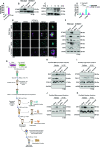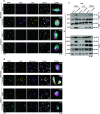STING dependent BAX-IRF3 signaling results in apoptosis during late-stage Coxiella burnetii infection
- PMID: 38459007
- PMCID: PMC10924102
- DOI: 10.1038/s41419-024-06573-1
STING dependent BAX-IRF3 signaling results in apoptosis during late-stage Coxiella burnetii infection
Abstract
STING (STimulator of Interferon Genes) is a cytosolic sensor for cyclic dinucleotides (CDNs) and initiates an innate immune response upon binding to CDNs. Coxiella burnetii is a Gram-negative obligate intracellular bacterium and the causative agent of the zoonotic disease Q fever. The ability of C. burnetii to inhibit host cell death is a critical factor in disease development. Previous studies have shown that C. burnetii inhibits host cell apoptosis at early stages of infection. However, during the late-stages of infection, there is host cell lysis resulting in the release of bacteria to infect bystander cells. Thus, we investigated the role of STING during late-stages of C. burnetii infection and examined STING's impact on host cell death. We show that the loss of STING results in higher bacterial loads and abrogates IFNβ and IL6 induction at 12 days post-infection. The absence of STING during C. burnetii infection significantly reduces apoptosis through decreased caspase-8 and -3 activation. During infection, STING activates IRF3 which interacts with BAX. BAX then translocates to the mitochondria, which is followed by mitochondrial membrane depolarization. This results in increased cytosolic mtDNA in a STING-dependent manner. The presence of increased cytosolic mtDNA results in greater cytosolic 2'-3' cGAMP, creating a positive feedback loop and leading to further increases in STING activation and its downstream signaling. Taken together, we show that STING signaling is critical for BAX-IRF3-mediated mitochondria-induced apoptosis during late-stage C. burnetii infection.
© 2024. The Author(s).
Conflict of interest statement
The authors declare no competing interests.
Figures









Similar articles
-
Coxiella burnetii induces apoptosis during early stage infection via a caspase-independent pathway in human monocytic THP-1 cells.PLoS One. 2012;7(1):e30841. doi: 10.1371/journal.pone.0030841. Epub 2012 Jan 27. PLoS One. 2012. PMID: 22303462 Free PMC article.
-
Drosophila melanogaster Sting mediates Coxiella burnetii infection by reducing accumulation of reactive oxygen species.Infect Immun. 2024 Mar 12;92(3):e0056022. doi: 10.1128/iai.00560-22. Epub 2024 Feb 16. Infect Immun. 2024. PMID: 38363133 Free PMC article.
-
Cell death induction facilitates egress of Coxiella burnetii from infected host cells at late stages of infection.Mol Microbiol. 2024 Mar;121(3):513-528. doi: 10.1111/mmi.15210. Epub 2023 Dec 19. Mol Microbiol. 2024. PMID: 38115201
-
The role of cGAS-STING signalling in liver diseases.JHEP Rep. 2021 Jun 24;3(5):100324. doi: 10.1016/j.jhepr.2021.100324. eCollection 2021 Oct. JHEP Rep. 2021. PMID: 34381984 Free PMC article. Review.
-
The cGAS-STING signaling in cardiovascular and metabolic diseases: Future novel target option for pharmacotherapy.Acta Pharm Sin B. 2022 Jan;12(1):50-75. doi: 10.1016/j.apsb.2021.05.011. Epub 2021 May 20. Acta Pharm Sin B. 2022. PMID: 35127372 Free PMC article. Review.
Cited by
-
Role of Type 4B Secretion System Protein, IcmE, in the Pathogenesis of Coxiella burnetii.Pathogens. 2024 May 14;13(5):405. doi: 10.3390/pathogens13050405. Pathogens. 2024. PMID: 38787259 Free PMC article.
-
Avellanin A Has an Antiproliferative Effect on TP-Induced RWPE-1 Cells via the PI3K-Akt Signalling Pathway.Mar Drugs. 2024 Jun 13;22(6):275. doi: 10.3390/md22060275. Mar Drugs. 2024. PMID: 38921586 Free PMC article.
References
Publication types
MeSH terms
Substances
Grants and funding
LinkOut - more resources
Full Text Sources
Molecular Biology Databases
Research Materials

